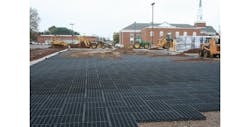The Cedar Springs Presbyterian Church low-impact parking improvements project in Knoxville, Tenn., began as an addition to meet the congregation’s parking needs and to provide a new site entrance to improve access and traffic circulation within the church campus. The desire to develop the property as good stewards and include “green” or sustainable design practices led to the decision for this 169-space, 60,000-sq-ft pervious parking project.
Project Scope
Some impervious parking was required to bring the church in compliance with the City of Knoxville’s parking requirements. Additional parking could be considered as “overflow,” and pervious pavement systems could be used as an alternative parking surface. A vegetated parking lot is typically recommended for occasional or infrequent use traffic—ideal for the Church parking needs. The Presto Geosystems Geoblock 5150 porous pavement system was selected after evaluating several pervious pavement options.
Selection Criteria & Green Benefits
Grass parking was a relatively new, sustainable parking surface that could support the traffic loading. The vegetated surface negated the need for pre- and post-storm water retention for the improvements. The vegetated surface allowed for both the maximum use of the church property by minimizing the area required for retention and correcting existing drainage issues.
The church envisioned a “park-like” setting with maximum green space, extensive landscaping and a minimal storm water retention footprint. To properly irrigate these features, an irrigation system fed from an on-site well was designed. It eliminated the need for processed potable water for irrigation needs, reducing the overall water consumption costs for the church campus.
Sustainable Design Considerations & Environmental Impact
The porous surface provides infiltration of rainfall with minimal amount of runoff, the grass surface reduces the heat island effects associated with asphalt and the porous pavement design allowed for the required 80% TSS removal without the inclusion of additional mechanical water quality devices or water quality detention ponds, therefore maximizing the use of the parking footprint on the church property.
Site Soil Considerations
The site is located within the lower portion of its watershed and is relatively level; this presented challenges in the design of the drainage facilities due to the low gradient. Other challenges included the presence of soft soils and topsoil, which required extensive undercut and replacement.
Performance & Results
Months after completion, the vegetated parking lot is functioning as planned and is heavily used for services and special events. The City of Knoxville has used this project as an example of successful urban low-impact development, and the church leadership is very satisfied with the results of the project. Maintenance of the grass pavement is similar to maintaining any grass surface.


